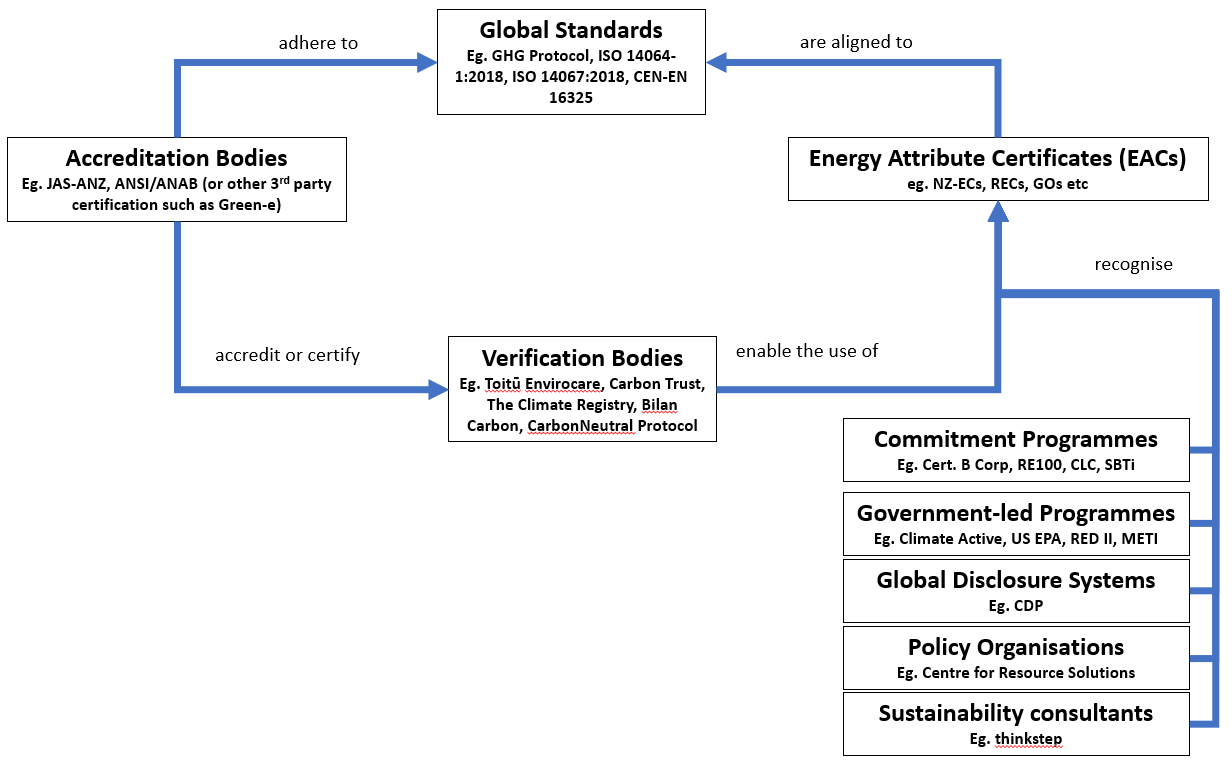Measuring and reporting on organisational carbon emissions is becoming more widespread. Whether you’re a listed company needing to meet your own reporting obligations, a proactive company responding to consumer demand, or, you’re preparing for the impending Taskforce on Climate-Related Financial Disclosure requirements, there are all sorts of reasons to measure and report your emissions, on the way to ultimately reducing them.
One of the first steps in this process is to understand your own business and what your impacts might be. Whether you are manufacturing products or are an office-based business, one of the most impactful areas is often energy use. Carbon accounting (or GHG reporting) is commonly used to measure and understand these areas of impact, precipitating a plan for how to reduce them. This is where NZ-ECs fit in (New Zealand Energy Certificates).
The purchase of energy attribute certificates (EACs), in this case NZ-ECs, acts as a proxy for the direct purchase of renewable energy, as the nature of energy transmission and distribution networks often makes this impossible. Buying EACs is a credible way of attributing specific production characteristics to consumed energy, and can be used as a basis for reporting emissions from energy use in many reporting frameworks.
Earlier this year, we asked thinkstep-anz to review how NZ-ECs fit into the various reporting frameworks most commonly used in New Zealand. Further to this, we have just published our own summary of the ways in which EACs are recognised and used around the world.
The sum of these two reports explains how users of the NZECS can be confident in their use of NZ-ECs as part of a robust approach to impactful energy purchasing, GHG reporting and emissions mitigation.
thinkstep-anz review
thinkstep-anz found that:
organisations can use EACs to demonstrate the procurement of renewable energy, support emission reduction plans and targets, reduce the offsets required for carbon neutral certification, and reduce exposure to climate-related risks.
Essentially, NZ-ECs support any organisation that is reporting against the GHG Protocol, ISO 14064-1, GRI, B Corp, is completing an Environmental Product Declaration, or Life Cycle Assessment, is committed to RE100 or is setting a science-based target, among others.
The report also describes that:
by purchasing EACs compliant with the Scope 2 Quality Criteria, consumers not only claim the use of 100% renewable electricity, but also drive up the emission factor of the residual grid/supply mix.
This feature is a fundamental part of market-based reporting. As energy consumers purchase EACs, the residual supply mix (used by other reporting parties) adjusts to ensure that no double-counting takes place. Usefully, as the residual supply mix emission factor increases it encourages other consumers to reduce their own emissions and provides a clear signal to the market of the demand for renewable energy.
NZECS Recognition Report
Building on the above, we felt it was important to provide some context as to how EACs are used internationally.
The evidence presented in this report shows robust existing international precedent for EACs as appropriate instruments within market-based GHG reporting.
The report describes recognition of NZ-ECs by global entities within certification and commitment programmes, government-led programmes, global disclosure systems, policy organisations and sustainability consultants.
The report also outlines and provides explanation of the important role that standards, accreditation bodies, verification bodies and EAC system providers all play in creating a robust environment for voluntary climate action (as per Figure 1).
Figure 1: Framework of relevant GHG reporting entities and their recognition of EACs

In the next few months, we are also looking at how to measure the impacts EACs have on increasing renewable energy generation and capacity, and reducing emissions. We will define what impact means to Certified Energy, and define the different categories of impact to enable linkages to reductions in carbon emissions.
Referenced documents:
The Role of Energy Attribute Certificates in Greenhouse Gas Emissions Reporting